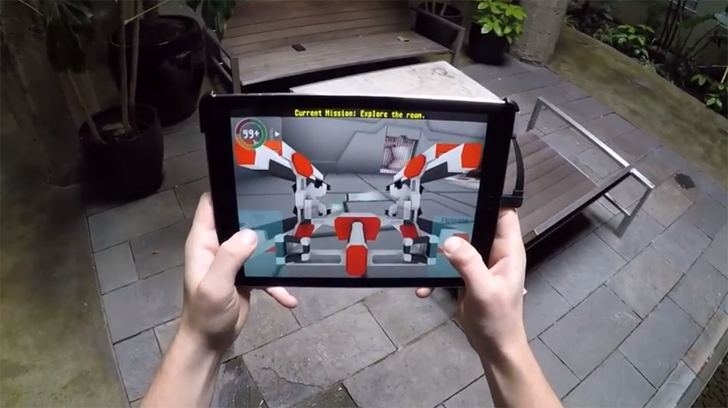Just this week, Occipital released SDK 0.4 for its powerful Structure Sensor, giving the 3D scanner the ability to track objects like never before. The start-up’s original announcement highlighted the new ability for the Structure to seamlessly scan items without losing site of them in the process. Today, Occipital has expanded those capabilities even further. With the Structure Sensor’s new unbound positional tracking, demonstrated at CES in January, users will now be able to use the device’s augmented reality features in really exciting new ways.
At CES, the Structure’s positional tracking ability allowed attendees to experience the Occipital booth through a colorful virtual world. Holding a Structure-equipped iPad in front of them, CES goers suddenly entered a VR experience in which they could pour vats of chemicals, knock into bricks, and shoot lasers all around the Occipital booth. Unlike other VR devices, the Structure’s unbounded positional tracking has no spatial constraints. The company’s press release explains:
Many current VR systems require either a camera facing the user, or a beacon placed in a room to track the position of the user. This means that the range within which the user’s movements can be tracked is limited by those external devices’ ability to sense the user.
The unbounded positional tracking enabled by the Structure Sensor does not require any kind of beacon or external camera, and has no spatial constraints; that is, it travels with the user, no matter where or how far they go, or how they move. It achieves this by using the Structure Sensor to actively map the user’s surroundings in 3D in real time.
Like the motion tracking feature used for seamless 3D scanning, the positional tracking is achieved through the use of the Structure’s depth sensor and the iPad’s color camera. While the motion tracking keeps focus on an individual object, as juxtaposed against a moving environment, the positional tracking creates a complete 3D map of the user’s entire surroundings, without any setup or markers necessary.
Though the Structure has always touted its VR/AR capabilities, using simple demo apps, this new feature expands the device from a 3D scanning sensor to something truly capable of virtual and augmented reality applications. With no beacon (like the HTC Vive) or user-facing camera (like the Oculus) tracking the user, the user is completely free to move around, as the press release suggests. And to demonstrate this, Occipital has made its CES experience available to all Structure owners around the world. The demo game is called STAR Ops and you can now find it at the App Store. See the trailer for the game below:
For even more footage of how STAR Ops operates in the real world, you can see a first-person play through in the video below:
As a puzzle game taking place in a futuristic world, STAR Ops showcases the Structure’s potential for AR gaming, but the sensor has even more potential for architecture, interior design, and medicine, among other things. From body scanning to create 3D printed prosthesis to displaying potential decor purchases within a living room, the device is among the first ushering in a world of ubiquitous 3D capture tools.
With its low price tag and use with iPad, the Structure Sensor is a gateway device, giving existing iPad owners something with which to begin interacting with digital world in 3D. And, starting this year, new tablets, notebooks, and PCs will begin incorporating 3D cameras directly so that, soon, 2D digital cameras will be a thing of the past.





